They explained that was all the money they had left in their treasury and Clancy could have it all if he'd stay!
Clancy relates the story of his first NHL game in the 1968 book "Clancy: The King's Story as Told to Brian MacFarlane";
My first game as pro! I can remember it like it was last night. We were scheduled to play in Hamilton, and they had players on their roster like Goldie Prodgers and Ken Randall and the two Mummery boys [Harry and Walter]. They were all big men, powerful men. The night before I left home for that encounter, my poor dad came down to the station in Ottawa and gave me the kind of advice that any father would give a boy going off to play his first professional game. He took me aside, told me not to worry, to do my best and a lot of other things. Then he shook my hand and wished me luck as I got on the train.
Now we're on the train and on our way, and I thought everything was just great. Every once in a while some passenger would come down the aisle and I could see he'd recognize some of the players. Now and again one the boys would be asked for his autograph. Nobody recognized me, of course, but I was tickled pink to be among the famous Ottawa Senators.
We stayed at the Royal Connaught Hotel in Hamilton and that was great too. The next morning going into breakfast, I learned something else. At home my breakfast usually meant a plate of porridge, a piece of toast and maybe a glass of milk. But these guys! They polished off everything! Double orders of bacon and eggs, flapjacks, sausages, toast, rolls, and gallons of milk. I'd never seen fellows eat like that in all my life! It was a revelation to see a bunch of hungry hockey players tie on the feedbag.
That night we headed out to the Barton Street Arena, the same arena that's used for hockey in Hamilton today. And if I thought I was going to get in a lot of ice time in my first game as a pro, I soon had another thing coming.
Frankie Boucher and I sat on the bench right though the sixty minutes of game time. We got a chance to warm up before the game and we took a whirl around the ice between periods, but during the actual play we didn't get a smell of the ice. Boucher didn't get the call; I didn't get the call. We're sitting there like a couple of dummies. Now we come to the end of regulation time and the game is tied 2-2. This mean we have to play overtime. The coach, Petey Green, taps me on the shoulder and says, "You go out there in place of [Eddie] Gerard on the defence." Then he turns to Boucher and says, "You go out there in place of [Frank] Nighbor at centre ice." Now this was sudden-death overtime and no time to be making mistakes, and here's the coach throwing two bushers out there in place of two of the greatest players in the game.
We just begin the overtime, when I get the luckiest break in the world. I remember getting the puck. It came back to me off the draw, and it looked like a big watermelon rolling my way. I slapped at it with my stick and stumbled on ahead with it before I let fly a pass across to Punch Broadbent. I kept going up the ice because I didn't have sense enough to stay back on defense where I belonged. Then, whoops-a-daisy, I get the puck right back again, but I was off at a poor angle and on the wrong side of the net when I took this pass. There wasn't much I could to but wing a shot at the net. I let go a backhander and, lo and behold, I look up and see the goal judge waving his handkerchief and wave it in the air. To me, this handkerchief looked at big as a bed sheet.
I had scored on my first shot as a professional in the National Hockey League, and it was a winning goal in sudden-death overtime. Naturally I was robbed by my teammates and it then dawned on me that I should keep the puck as a souvenir. When I went after it, the Hamilton goalkeeper, a fellow by the name of [Howie] Lockhart, just glared at me. I never did know why, until a couple of years later when I met him outside the rink one day and asked him why he would do such a thing. He said it was because the puck went though a hole in the netting at the side of the goal! It hadn't gone in the front at all and so it shouldn't have counted!
But my first goal did count and we beat Hamilton 3-2 on that shot of mine. To this day I'm not sure whether to be proud of it or embarrassed by it. But scoring that goal on my first shot in the big leagues did one thing for me. It gave me a little confidence. My teammates hadn't see how the puck went in and they couldn't care less. In the shower after the game, Gerard, whose place I'd taken, came over to me and said, "Frankie, that was a terrific shot!:" I thought it was too - until this fellow Lockhart told me what he thought about it some time later.The "goal" would be one of just four Clancy would score as an NHL rookie in 24 games that season. Clancy would play nine seasons with the Senators, winning Stanley Cups in 1923 and 1927 and being named their captain in 1928, before moving on to the Toronto Maple Leafs in 1930 in exchange for $35,000 and two players as the struggling Senators began to sell of their most valuable assets in an effort to stay in business.
Clancy would play for the Maple Leafs for seven seasons, winning another Stanley Cup in 1932, where his charismatic personality, combined with his small size and extra large toughness, would make him a beloved icon in Toronto.
Clancy was said, according to McFarlane, to have started a thousand fights and never won any of them. At the time of his retirement in 1937, Clancy was the highest scoring defenseman in NHL history with 136 goals in 592 games, with his best season coming in 1930 with 17.
Following his playing days, Clancy became an NHL referee for 11 years before he went into coaching, first in the American Hockey League, which included a Calder Cup championship with Pittsburgh in 1952.
Clancy was inducted into the Hockey Hall of Fame in 1958 and the Canada Sports Hall of Fame in 1975. In 1998, he was ranked #52 on The Hockey News list of the 100 Greatest Hockey Players.
One further tribute was bestowed on the legendary Clancy when the King Clancy Memorial Trophy was named in his honor and is awarded annually since 1987 to the NHL player who demonstrates leadership qualities on and off the ice and who has made exceptional humanitarian contributions on the community.
Today's featured jersey is a 1922-23 Ottawa Senators King Clancy jersey. The Senators wore their barber pole jerseys for each of their 14 seasons in the NHL, a style which actually dates back to the turn of the century years prior to the formation of the NHL.
The Senators occasionally wore a special patch commemorating their standing as league champions and in 1929 an "O" crest arrived, but the black, red and white stripes were a constant, both at home and on the road, as the first road jersey did not arrive until the 1927-28 season when the newly renamed Maple Leafs introduced a white jersey to be worn for games against the New York Rangers, who also wore blue sweaters.
Bonus jersey: Today's bonus jersey is a 1931-32 Toronto Maple Leafs King Clancy jersey. This white jersey was the first road jersey in NHL history, necessitated by the green-clad Toronto St. Patricks being sold and changing their name to the Toronto Maple Leafs during the 1926-27 season.
When the Maple Leafs introduced a new blue jersey for the 1927-28, the New York Rangers were already wearing blue, which, for the first time in league history, necessitated a special jersey to avoid the confusion of both teams wearing blue sweaters. It would not be until six seasons later in 1933-34 that the New York Americans would become the second team to wear two different sweaters during a season.

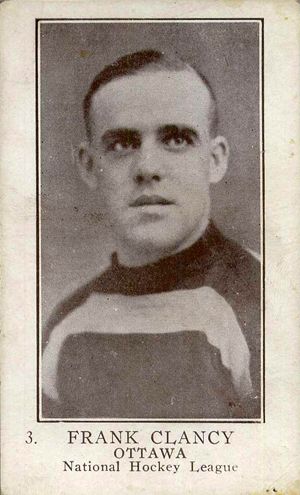
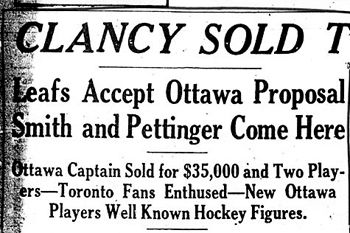
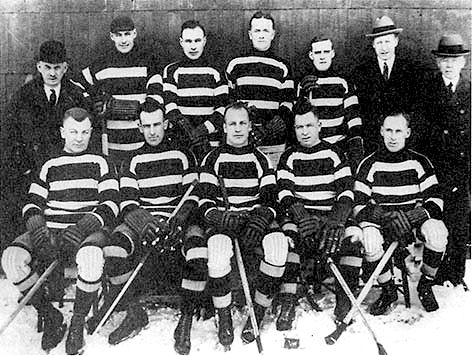
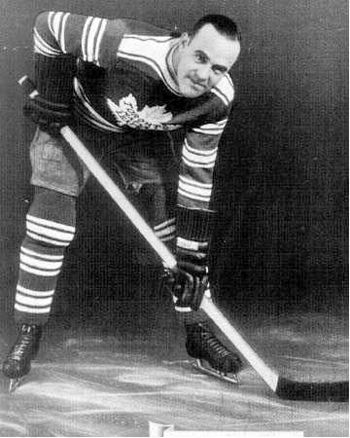
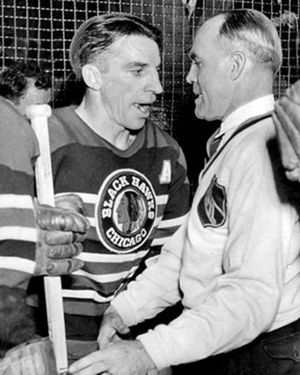

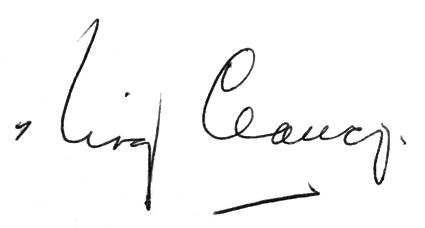
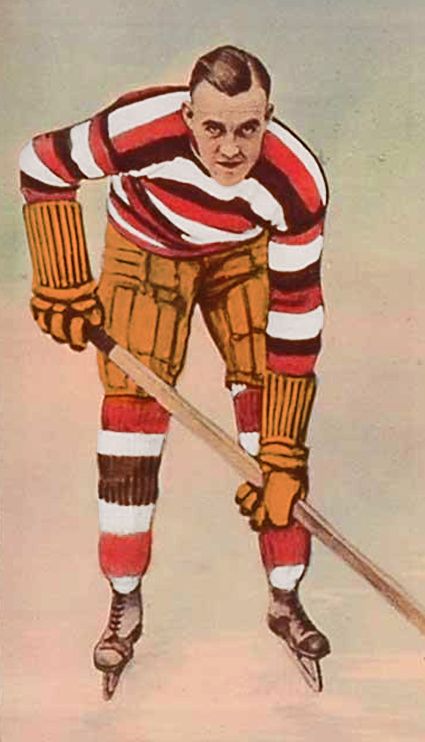
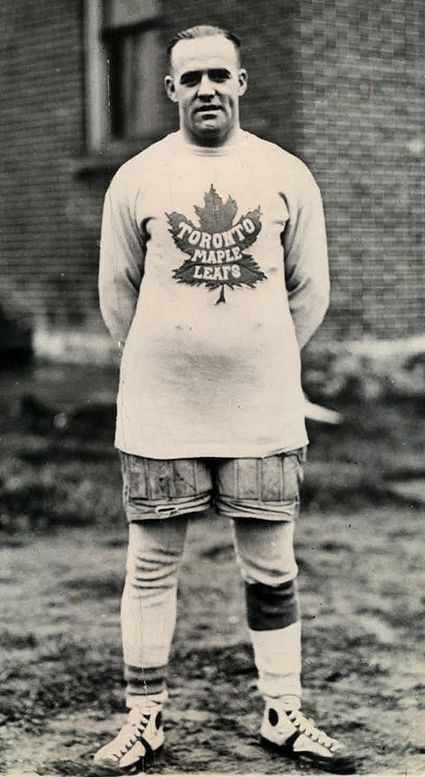










No comments:
Post a Comment
We welcome and encourage genuine comments and corrections from our readers. Please no spam. It will not be approved and never seen.